2003 Case: A Case Of A Mis-diagnosis.
The Shih Tzu had a Dermoid, Not a Pterygium
Dr Sing
Kong Yuen, BVMS (Glasgow), MRCVS
Case first written in 2003.
Case updated:
29 December, 2014
"Have you snipped
off the Shih Tzu's hairs growing from the white tissue covering the
left side of its cornea at 9 o'clock?" I asked the pet shop girl for
the fifth time over several days.
The thick white tissue was snow white and looked like a wing. Hence
its medical term is dermoid. People like sun lovers do
suffer from dermoid which is said to be caused by excessive exposure
to ultraviolet light but this puppy was born with a dermoid.
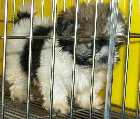
The dermoid had grown from the conjunctiva which is the tissue
covering the sclera (eye white) and advanced to cover the left side
of the cornea of the right eye.
When the pet shop girl wiped the eye discharge during one of my
visits, I saw hairs growing from the dermoid which is unusual as a
pterygium should not have hairs. (THE EYE CONDITION IS A DERMOID,
NOT A PTERYGIUM - see e-mails below).
These hairs irritated the eye and cause inflammation and eye
discharge overnight.
It was uncomfortable for this puppy and I could only pester the pet
shop girl to snip off the hairs as veterinary surgery was not
advised in such a young age.
"No," the pet shop girl apologised. "I have been busy with my work."
She needed to be careful not to puncture the cornea and that might
be the reason she had procrastinated.
The pet shop girl loved animals and usually swiped off the sticky
yellow eye discharge with a piece of tissue paper before showing me
the puppy. I saw the hairs clump together and stand out vertically
during one such visit.
The discharge
was seen the next day when I visited the pet shop to vaccinate the
other puppies. The puppy would feel uncomfortable and rub the eye.
Soon, it would get infected sore eyes.
This three-month-old Shih Tzu pup was amongst ten imported from
Australia.
"Can the dermoid be removed by surgery?" the pet shop proprietor
asked as I vaccinated the puppies.
He would not be able to sell it as fast as the other puppies. Who
would want to buy a defective puppy for nine hundred and fifty
dollars?
"It happens to
other pet importers too," I said. "Some Australian pet exporters
will throw in a healthy puppy with a defect occasionally and this
means extra veterinary costs for treatment or a loss for you as
nobody wants to buy the puppy."
I examined this very cuddly Shih Tzu. "The surgery will not
remove this dermoid completely as there are chances of recurrence.
There will be a scarred tissue over the cornea where the dermoid had
been removed."
I elaborated: "A very young puppy is a high anaesthestic risk and it
may die on the operation table." This means a total loss to
the pet shop proprietor.
"Furthermore, there will be a scarred cornea after removal of the
dermoid and therefore the defect would still be obvious."
What the pet shop proprietor wanted was a clear cornea and if I
could not give him what he wanted, I should not advise surgery as
this would cost him money. The anaesthesia and surgery would
cost him at least two hundred dollars.
Singapore shop rentals are very high as demand is greater than
supply and it is best to save him money if the cosmetic surgery
would not guarantee a perfect clear cornea.
"It will be better to inform the prospective buyer of the eye
defect, sell it much cheaper and let the new owner seek veterinary
treatment."
The pet shop
proprietor decided to sell the puppy at a lower price but there were
no buyers for the next two weeks. The older the puppy grows, the
harder it will be to sell to most Singaporeans as they buy the
youngest puppies available.
I remember this Shih Tzu very well as dermoids are rarely
encountered by veterinarians.
Snipping off
the hairs would help and it was best done by the pet shop girl.
I guessed there was too much harassment from me. On the sixth
phone call, the pet shop girl who was also a very experienced and
fast dog groomer finally took up her scissors to trim the hairs.
 "Are
there any more eye discharge the next day?" I asked her. "Are
there any more eye discharge the next day?" I asked her.
"Much less," she said and continued with her work.
"Was there anybody interested in buying this puppy?" I asked as
three weeks had passed.
"No," she replied. "The right owner had not presented himself yet."
She believed in fate. Fate brings people and circumstances together.
I doubt anybody will buy this Shih Tzu. What will happen to this
Shih Tzu if there are no buyers? I don't really know.
When it grows older, surgical removal of the dermoid will be needed
as it affects the vision. My concern was the inflammation of the eye
as the dog may feel that it has a foreign body and keeps rubbing its
eye, leading to blindness later in life.
Many Singaporean pet owners tend to get advice from the pet shop
girls who will usually suggest eye drops for eye problems in their
pets to save on veterinary consultation costs.
Many will use the potent eye drops prescribed for members of their
family. No amount of eye drops will dissolve a dermoid. This
Shih Tzu would need surgery when it is older to get the dermoid
removed by the vet. |
2003 Case: A Case Of A Mis-diagnosis.
The Shih Tzu had a Dermoid, Not a Pterygium.
Amendments made.

| E-mail
on April 11, 2008
Dear Judy
I am an eye surgeon in UK and by chance came across an article (see
link:
031803Shih_Tzu_pterygium_Singapore.htm
(above report),
which I believed originated from your practice. I know it has been a
while since it was written but I just wanted to inform the vet that
treated the dog's eye that it is a dermoid and not a pterygium. It
has hair as the lesion is a teratoma. It can be removed by
superficial keratectomy but it is much more difficult than removal
of a pterygium and may be a patch graft (not sure if this is
available for dogs?).
Hope this helps
b/w
Say Aun Quah |
E-mail reply on April 20, 2008
Hi
I am Dr Sing from Toa Payoh Vets. I am very grateful to you for
taking the time to write to us. We could not find the article to
correct the mistake earlier. 5 years have passed quickly as the
pictures were taken in 2003 . It is good
that you have found the article in the internet and informed us. The puppy's eye
condition is a dermoid, not a pterygium. Thank you for writing
to us.
Amended pictures are presented as follows:
|
 |
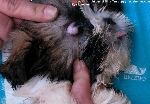 |
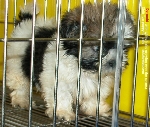 |
Amendments in the above pictures. The Shih
Tzu puppy's right eye condition is a dermoid, not a pterygium
as labelled in 2003 pictures in the report above |
| |
|
|
2014: A Case Of A
Dermoid in a Shih Tzu videoed at Toa Payoh
Vets |
| |
|
 |
 |
|
Video: Dermoid in a Shih
Tzu's eye |
|
| |
|
CORNEAL DERMOID SURGERY IN DOGS
It seems that
corneal dermoids are rare in
young dogs in
Singapore. These few cases I am aware of,
occur in Shih Tzu puppies. Shih Tzu breeders may see more
cases than vets. A quick internet check - one case in a Shih Tzu in another country.
See the internet posting reproduced below:
2005 website
posting from the internet of a dermoid
in a Shih Tzu
Hello, I just purchased a shih tzu from a breeder.
Two days before I picked him up, I was told that during
the vet visit, it was found that the puppy has a
lateral corneal
dermoid cyst on its
left eye and must be removed. I was a bit
hesitant but the opthalmologist assured me that this has
no long term effect on the shih tzu and that it will
live a normal life with no
visual impairments. I took the precious puppy
home after the surgery and he seems to be doing fine. I
have been applying antibiotic drops three times a day to
the affected eye. However, there is a white film that is
visible on the operated eye. Has anyone had this
experience before? Is that normal? I am just worried. |
| |
|
| |
|
2009 Case: Corneal
Dermoid Surgery in a Shih
Tzu at Toa Payoh
Vets
Dr Sing
Kong Yuen, BVMS (Glasgow), MRCVS
Case written:
29 December, 2014
The owner
requested surgery to remove the
corneal dermoid as it was
impairing the dog's vision. In
2009, I had not started using
videos. The surgery was recorded
using images. |
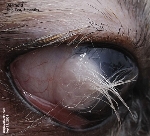 |
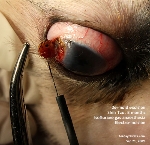 |
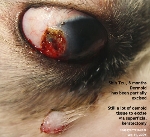 |
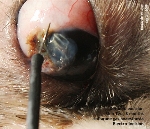 |
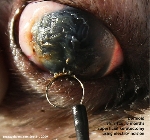 |
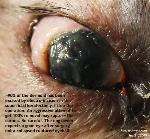 |
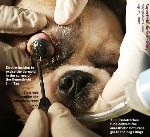 More information about the anaesthesia
in the 2009 case is at: More information about the anaesthesia
in the 2009 case is at:
Dermoid Excision Using Electro-surgery |
|